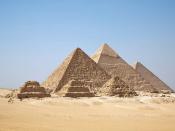Ancient Egyptian and Greco-Roman practices of preparing the dead for the next cradle of humanity are very intriguing. These two cultures differ in a multitude of ways yet similarities can be noted in the domain of funerary services. In the realm of Egyptian afterlife, The Book of the Dead can provide one with vital information concerning ritual entombment practices and myths of the afterlife. The additional handouts I received from Timothy Stoker also proved to be useful in trying uncover vital information regarding the transition into another life. Regarding the burial practices of Greece and Rome, parts of Homer's Odyssey are useful in the analysis of proper interment methods.
One particular method used by the Egyptians was an intricate process known as mummification. It was undoubtedly a very involved process spanning seventy days in some cases. First, all the internal organs were removed with one exception, the heart. If the body was not already West of the Nile it was transported across it, but not before the drying process was initiated.
Natron (a special salt) was extracted from the banks of the Nile and was placed under the corpse, on the sides, on top, and bags of the substance were placed inside the body cavity to facilitate the process of dehydration. After thirty-five days the ancient embalmers would anoint the body with oil and wrap it in fine linen. If the deceased was wealthy enough a priest donning a mask of Anubis would preside over the ceremonies to ensure proper passage into the next realm.
One of the practices overseen by the priest was the placing of a special funerary amulet over the heart. This was done in behest to secure a successful union with Osiris and their kas. The amulet made sure the heart did not speak out...


